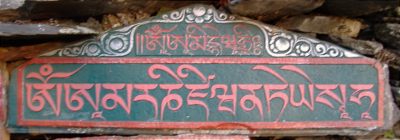
Image of Amitabha from : http://rywiki.tsadra.org/index.php/Amitabha
BAHA’I APOLOGETICS AND THE GREATEST NAME BAHA’ AS A "GLORY" MOTIF IN ASIAN RELIGIOUS SCRIPTURE
Stephen Lambden UCMerced.
In progress and under revision 1980s-2017.
.
The Arabic word bahā' and its derivitives obviously do not occur directly in the Sanskrit, Gāthīc, Avestan, Pali, Chinese, Japanese and other scared texts of the non-Semitic Bahā'ī-recognized Asian religions (Hinduism, Zoroastrianism, Buddhism). Words of identical or similar meaning are, however, found in eschatological contexts or texts which Bahā'īs have found prophetically significant. A Sanskrit root B-H-Ā signifies `to shine'. Related Sanskrit, Pali and other words (i.e. ābhāti = `shines towards'; ābhā = `lustre, splendour'), though etymologically/linguistically unrelated, remind one of derivatives of the Arabic verbal root B.H.A [W] -- including bahā' and abhā. Various stanzas of the eleventh chapter of the Bhagavad Gÿta -- such as the use of bhā (= `Light', `Glory') in 11:12 -- detailing the "glory" of the transfigured Krishna have, by certain Bahā'īs, been seen to be prophetic (i.e. Munje, ..World, 50-51 on Gīta 11:30). [28]
Such Messianic figures as Kalki, the tenth Avatār of Vishnu or the "reincarnation of Krishna", expected by some Hindus, the Zoroastrian Shāh Bahrām [Vahrām, Verethraghna // Saošyant] are all pictured as manifesting some kind of aura of glory; a supernatural splendour comparable to the bahā' ("radiant glory") of Bahā’-Allāh. The Zoroastrian saviour, for example, incarnates the Khvarenah (Avestan; Pahlavi khwarr, New Persian khurrah / ADD arr) or supernatural "splendour".
The Arabic word bahā' and its derivitives obviously do not occur directly in the Sanskrit, Gāthīc, Avestan, Pali, Chinese, Japanese and other scared texts of the non-Semitic Bahā'ī-recognized Asian religions (Hinduism, Zoroastrianism, Buddhism). Words of identical or similar meaning are, however, found in eschatological contexts or texts which Bahā'īs have found prophetically significant. A Sanskrit root B-H-Ā signifies `to shine'. Related Sanskrit, Pali and other words (i.e. ābhāti = `shines towards'; ābhā = `lustre, splendour'), though etymologically/linguistically unrelated, remind one of derivatives of the Arabic verbal root B.H.A [W] -- including bahā' and abhā. Various stanzas of the eleventh chapter of the Bhagavad Gita -- such as the use of bhā (= `Light', `Glory') in 11:12 -- detailing the "glory" of the transfigured Krishna have, by certain Bahā'īs, been seen to be prophetic (i.e. Munje, ..World, 50-51 on Gīta 11:30). [28]
Hinduism, Vishnu and Kalki
Such Messianic figures as Kalki, the tenth Avatār of Vishnu or the "reincarnation of Krishna", expected by some Hindus, the Zoroastrian Shāh Bahrām [Vahrām, Verethraghna // Saošyant] are all pictured as manifesting some kind of aura of glory; a supernatural splendour comparable to the bahā' ("radiant glory") of Bahā’-Allāh. The Zoroastrian saviour, for example, incarnates the Khvarenah (Avestan; Pahlavi khwarr, New Persian khurrah / ADD arr) or supernatural "splendour".
The name of the centrally important Mahāyāna Buddha Amitābha, the ruler of the western paradise of Sukhāvatī, in Sanskrit signifies "Boundless/ Infinite Light". While then, the word bahā' has no linguistic cognate in the languages of the Asian religions, there are a number of theological motifs that are for Bahā’īs suggestive of the messianic splendour of the "greatest name" as bahā'. In Sanskrit Amitābha means “Infinite Light". This great Buddha figure, for some an elevated teacher or saviour, is also also known as Amitayus (“Infinite Life”) and in Japanese Amida, The first component of this name amita means, "unmeasured, boundless, infinite" while the second, ābha has meanings very similar to those of the Arabic baha' , namely "splendour, light; colour, appearance, beauty" Skt. bha := light, lustre, splendour).
Buhhhism : Maitreya, Amitābha.and the Ultimate Splendour.
The name of the centrally important Mahāyāna Buddha Amitābha, the ruler of the western paradise of Sukhāvatī, in Sanskrit signifies "Boundless Light". While then, the word bahā' has no linguistic cognate in the languages of the Asian religions, there are a number of theological motifs that are for Bahā’īs suggestive of the messianic splendour of the "greatest name" as bahā'. In other Asian languages Amitābha. has the following names:
Amitābha is especially associated with the land or realm of Sukhāvatī ("Happy", "Blissful", etc) in the two main, large and small Sukhāvatīvyūha sūtras. For many, the supremely powerful Amitābha mantra, is centered on him. in Sanskrit ytansliteration is oṃ amitābha hrīḥ

"This mani stone in Sikkhim shows the Amitāyus mantra as the Tibetans write it in the Uchen script".
The entry Amitabha' is the Encyclopædia Britannica sets out some basic facts:
"in Mahayana Buddhism, and particularly in the so-called Pure Land sects, the great saviour buddha. As related in the Sukhavati-vyuha-sutras (the fundamental scriptures of the Pure Land sects), many ages ago a monk named Dharmakara made a number of vows, the 18th of which promised that, on his attaining buddhahood, all who had faith in him and who called upon his name would be reborn in his paradise and would reside there in bliss until they had attained enlightenment. Having accomplished his vows, Dharmakara reigned as the buddha Amitabha in the Western Paradise, called Sukhavati, the Pure Land. Devotion to Amitabha came to the fore in China about 650 ce and from there spread to Japan, where it led in the 12th and 13th centuries to the formation of the Pure Land school and the True Pure Land school, both of which continue to have large followings today. Depictions of Amitabha’s Pure Land and of Amitabha descending to welcome the newly dead are beautifully expressed in the raigō paintings of Japan’s late Heian period (897–1185)" (see further bib. below).
Bibliography
Encyclopædia Britannica article ` Amitabha'.
Visible Mantra :
Pure Land Sutras.
The Corporate Body of the Buddha Educational Foundation - Pure Land Sutras. Translated into English from Sanskrit MSS by F. MAX MÜLLER and others. Reprinted from SBE., Taiwan :



